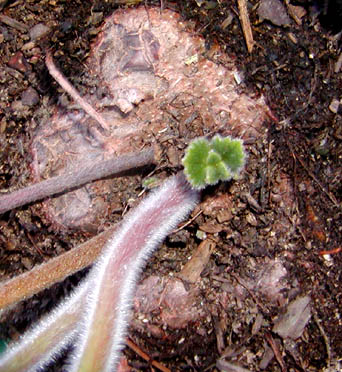|
Sinningia polyantha has a fairly typical "bagel" top, with a raised ridge surrounding a sunken growing area bearing protuberances representing previous year's stems. The new year's stems emerge from the axils at the base of the old stems. It is quite unlike the inverted-cone tuber of S. ramboi, or the flattened dome tuber of S. douglasii, with which it has been compared. The plant was discovered growing in sandy soil near the Atlantic Ocean in Brazil, but the tuber does not look all that different from tubers of other species growing on (e.g.) rocky hillsides. The stems are not necessarily deciduous. One of my tubers of this species rotted during the winter rains of early 2005 even though it still had 16-inch [40-cm] tall stems fully leafed out. |

|